|
Advantech SOM-6894
Intel "Haswell" Core i7/i5/i3/Celeron-powered space-saving COM Express Compact module provides a wide range of performance and functionality for embedded systems projects
(by Conrad H. Blickenstorfer)
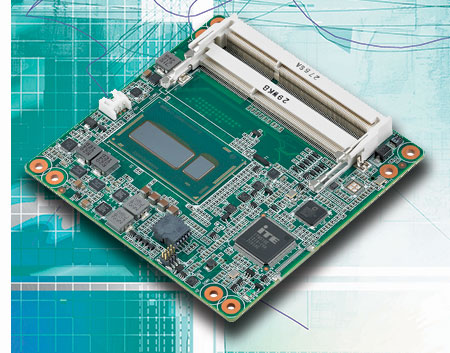 The Advantech SOM-6894 is a COM Express Compact module that can be ordered with one of four different Intel "Haswell" Celeron or 4th Generation Core i3, i5 and Core i7 processors, giving application engineers powerful CPU platform choices to streamline the product development process and accelerating time-to-market. Though the board measures just 3.75 x 3.75 inches (95 x 95 mm), it can provide substantial performance as well as support high-speed interfaces to carrier boards, such as USB 3.0, PCIe Gen3, and SATA Gen3. The Advantech SOM-6894 is a COM Express Compact module that can be ordered with one of four different Intel "Haswell" Celeron or 4th Generation Core i3, i5 and Core i7 processors, giving application engineers powerful CPU platform choices to streamline the product development process and accelerating time-to-market. Though the board measures just 3.75 x 3.75 inches (95 x 95 mm), it can provide substantial performance as well as support high-speed interfaces to carrier boards, such as USB 3.0, PCIe Gen3, and SATA Gen3.
The SOM-6894 is a highly integrated processor component that combines audio, video, and network functions with Intel "Haswell" Celeron and 4th generation Core processing power and technology advancements. As such, it brings a superior level of performance into existing COM Express solutions, or it can form the basis for COM Express projects providing previously unattainable levels of functionality and performance for intelligent systems projects.
The COM Express standard
COM stands for Computer On Module. COM Express, introduced in 2005 by the PICMG consortium, is a standard based on serial differential signaling technology for use in high performance embedded computing projects that require maximum I/O bandwidth, such as medical imaging, industrial automation, mapping, security, aerospace, etc.
COM Express boards are often used for applications where older/legacy standards are no longer powerful enough. COM Express modules are small, too. COM Express Basic modules measure just 4.92 x 3.74 inches (125 x 95mm), with an extended form factor measuring 6.1 x 4.3 inches (155 x 110 mm). COM Express Compact, the standard used for the SOM-6894, employs a square 95 x 95 mm format. Even more compact is COM Express Mini, with a footprint of just 84 x 55mm.
Just like COM Express is a form factor that actually comes in several forms, it's also a standard that comes in several types with different pin-outs and support for different interfaces and numbers of ports.
When/why do you need it?
COM Express modules such as the Advantech SOM-6894 are not meant to be stand-alone computers; they are more like components that can be selected and replaced depending on the need of a solution. They do provide the most complex part of any computer (the CPU board) and ancillary circuitry, eliminating system integrators' need to start from scratch when creating complex embedded systems projects, saving time and money in the process.
The overall idea with COM Express is that the modules provide the basic computing power, but that all the customization and special functionality for a project takes place on an application-specific carrier board. COM Express boards allow system integrators to concentrate on their applications. Since they only include the CPU and some related circuitry, COM-Express boards are small and fit almost anywhere. They are also inherently more rugged than full-size boards.
Below on the left you can see the top of the SOM-6894 board Advantech sent us for testing. Ours came equipped with a Celeron 2980U processor, which is the low-end processor for this board, but still part of Intel's 4th generation "Haswell" lineup. Note that the picture doesn't show the required cooling sink and fan that covers the entire board. Below on the right is Advantech's introduction video for the SOM-6894. We decided to include that here so interested parties won't have to Google for it.
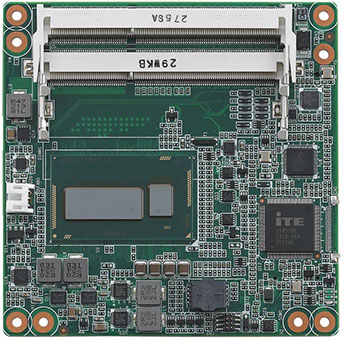 
Note that like all standardized CPU boards, COM Express Compact boards connect to a carrier/solutions board (which usually looks like a motherboard) via standardized connectors. COM Express uses one or two 220-pin edge connector, where one connector handles PCI, PCIe and IDE and the other connector everything else. Check the Wikipedia entry on COM Express boards for detail (see here).
RAM connectors are on the COM Express module itself (there are two SODIMM slots on the SOM-6894), but all other expansion boards will be located on the carrier board.
A Celeron in the Intel 4th generation Core processors lineup?
Perhaps the most attractive feature of the Advantech SOM-5894 is that it's available with a broad variety of Intel's 4th generation of embedded Core processors. What's special about this latest gen of high-end Intel chips? A lot, and it goes well beyond just speed. Codenamed "Haswell," this processor generation draws less power thanks to a new active/idle power state, and offers much better integrated graphics performance. All native SATA ports have 6.0 Gb/s support, there's the new "Lynx Point" 8-series chipset, the chips can drive three independent displays, there's USB port setting flexibility (USB 2.0 or 3.0), and there are numerous underlying enhancements and new technologies. As for performance itself, Intel claims 4th gen improvements of up to 13% CPU and up to 32% in 3D graphics over comparable 3rd gen systems. Note that even i3 processors support dual threads per core in Haswell, though "turbo boost" remains a province of the higher-end i5 and i7 processors.
Below you can see the major features and differentiation of the chips offered with the SOM-6894:
|
Advantech SOM-6894 Available Processor Comparisons
|
|
CPU COMPARISON
|
Celeron 2980U
|
i7-4650U
|
i5-4300U
|
i3-4010U
|
|
Lithography
|
22 nm (Haswell)
|
22 nm (Haswell)
|
22 nm (Haswell)
|
22 nm (Haswell)
|
|
Cores/Threads
|
2/2
|
2/4
|
2/4
|
2/4
|
|
Base clock speed
|
1.6GHz
|
1.7GHz
|
1.9GHz
|
1.7GHz
|
|
Max turbo speed
|
no turbo
|
3.3GHz
|
2.9GHz
|
no turbo
|
|
Max TDP
|
15 watts
|
15 watts
|
15 watts
|
15 watts
|
|
Smart Cache
|
2 MB
|
4 MB
|
3 MB
|
3 MB
|
|
Graphics
|
Intel HD (10 EUs)
|
Intel HD 5000 (40 EUs)
|
Intel HD 4400 (20 EUs)
|
Intel HD 4400 (20 EUs)
|
|
Intel vPro
|
no
|
yes
|
yes
|
no
|
|
AES new instructions
|
no
|
yes
|
yes
|
yes
|
|
Trusted Execution Technology
|
no
|
yes
|
yes
|
no
|
For a more detailed listing of the four processors available for the Advantech SOM-6894, check here.
What it all boils down to here in terms of capabilities, the SOM-6894 supports four PCIe x1, four 6Gb/s SATA III channels, two USB 3.0 (and 8 USB 2.0) ports, 8-bit GPIO, HD audio, and up to 16GB of DDR3L 1333/1600 MHz non-ECC unbuffered RAM in two 204-pin SODIMM slots. And, impressively, the SOM-6894 can support three independent displays via VGA, LVDS, and DVI/HDMI/DisplayPort.
What performance does the Haswell Celeron deliver?
Testing a CPU module is a bit trickier than testing a full mobile product (you just turn it on) or even a conventional motherboard (you connect a display, disk and keyboard). Fortunately, Advantech sent us one of 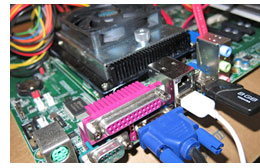 their standard SOM-DB5800 development boards that serves as a module carrier. The SOM-DB5800 looks very much like your average desktop motherboard with all the usual connectors and battery of ports. However, the DB5800 also has connectors to accommodate a COM-Express board with Type 6 and Type 10 pin-outs as it does not have its own CPU and chipset. their standard SOM-DB5800 development boards that serves as a module carrier. The SOM-DB5800 looks very much like your average desktop motherboard with all the usual connectors and battery of ports. However, the DB5800 also has connectors to accommodate a COM-Express board with Type 6 and Type 10 pin-outs as it does not have its own CPU and chipset.
We used a desktop class power supply to provide ATX power, a 22-inch HP LCD display via standard VGA, and a Toshiba 2.5-inch hard disk with Windows Embedded Standard 8 on it, prepared by Advantech.
After we ran our standard benchmark suites—PassMark and CrystalMark—we took the opportunity to compare the performance of this Haswell Celeron-powered COM Express Compact board from Advantech with some other Advantech COM Express modules we had tested in our lab over the past three years. The modules selected came with a very wide variety of processors, ranging from the current 4th gen Core processors, to modules with a 2nd gen Core processor, as well as some lower-end Intel Atom CPUs.
|
Advantech SOM Module Benchmarks and Comparisons
|
|
PERFORMANCE COMPARISON
|
Advantech
|
Advantech
|
Advantech
|
Advantech
|
Advantech
|
|
Model
|
SOM-6894
|
SOM-5894
|
SOM-5890
|
SOM-6765
|
SOM-7565
|
|
Model (click pic for review)
|

|

|

|

|

|
|
Type
|
COM Express Compact
|
COM Express Basic
|
COM Express 2.0
|
COM Express Compact
|
COM Express Mini
|
|
Year tested
|
2014
|
2014
|
2011
|
2012
|
2013
|
|
Intel CPU tested
|
Celeron 2980U
|
Core i5-4402E
|
Core i7-2715QE
|
Atom D2700
|
Atom N2600
|
|
CPU Speed std/turbo
|
1.6GHz
|
1.6/2.7GHz
|
2.1/3.0GHzGHz
|
2.13GHz
|
1.6GHz
|
|
OS Software
|
WES8.1
|
WES7
|
WES
|
Win7
|
WES7
|
|
Thermal Design Power (TDP)
|
15 watts
|
25 watts
|
45 watts
|
3.5 watts
|
3.5 watts
|
|
CPU Mark
|
1,364.6
|
3,542.3
|
4,099.9
|
631.9
|
488.6
|
|
2D Graphics Mark
|
287.9
|
589.6
|
311.6
|
48.0
|
67.3
|
|
Memory Mark
|
447.3
|
1,136.4
|
795.8
|
292.6
|
227.3
|
|
Disk Mark
|
627.8
|
1,801.5
|
150.7
|
849.7
|
571.2
|
|
3D Graphics Mark
|
229.4
|
399.3
|
325.3
|
95.2
|
82.1
|
|
Overall PassMark
|
642.3
|
1,651.76
|
1,363.0
|
411.4
|
306.3
|
|
CM ALU
|
19,854
|
38,348
|
53,083
|
14,235
|
10,699
|
|
CM FPU
|
17,266
|
39,994
|
54,374
|
10,567
|
8,307
|
|
CM MEM
|
21,946
|
40,963
|
27,262
|
8,842
|
6,753
|
|
CM HDD
|
10,535
|
30,482
|
8,974
|
13,383
|
10,936
|
|
CM GDI
|
10,260
|
16,474
|
5,691
|
2,157
|
1,536
|
|
CM D2D
|
6,167
|
6,136
|
3,041
|
824
|
643
|
|
CM OGL
|
8,180
|
10,189
|
2,711
|
9,632
|
7,174
|
|
Overall CrystalMark
|
94,208
|
182,586
|
155,136
|
59,640
|
46,048
|
The results, of course, are relative as they were obtained with such a wide variety of processors, from high end Core chips, all the way down to low-end Atom CPUs. What's interesting is that there IS such a very wide range of performance and features available in the COM Express standard (for Advantech's current lineup of COM Express Compact modules, see this page).
Perusing the benchmark results, note the massive processor performance difference between Core and Atom CPUs, a large difference that extends to graphics performance as well (though some Atom processors perform amazingly well in OGL tests). Note the very substantial difference in graphics performance between the 4th gen SOM-5894 and the 2nd gen SOM-5890.
Also note that module performance alone does not guarantee overall systems performance. Equipped with Intel solid state storage, the SOM-5894 absolutely scorched through the disk benchmarks, whereas older mass storage technologies and interfaces yielded far lower results. It always pays to keep storage media performance in mind!
As for the SOM-6894 with the low-end Celeron option, the board certainly held its own. Its overall performance is no match for the higher end 4th-gen Core processors, but it is easily twice as fast as boards powered by the very competent and popular Intel Atom N2600. It's about half as quick as the Intel 2nd gen Core i7-powered SOM-5890 we tested three years ago.
What's a bit confusing here is that for years Intel used the Celeron name for lowest-end bargain basement chips, but now the name is used both for low-end Haswell processors and certain mid-range "Bay Trail" chips based on the Intel Atom architecture. In addition, the performance of the integrated Intel graphics in the chips available for the SOM-6892 varies greatly. For systems integrators this means studying the Intel spec sheets and tables harder than ever!
Below is a schematic of the Advantech SOM-6894:
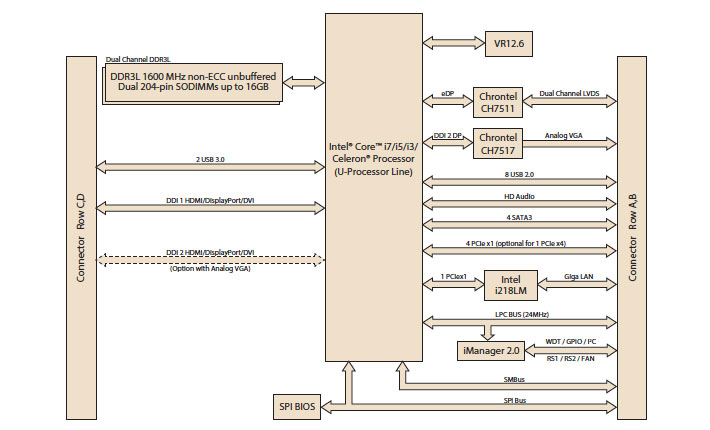
Computer modules like the Advantech SOM-6894 are very different from the mobile computing devices we generally review and test here at RuggedPCReview.com. What they all have in common is industrial quality build and components, as well as the inherent ruggedness required to function flawlessly under trying operating conditions.
What will most SOM-6894 modules be used for? Hard to say. These are very small, space-saving configurations with a wide range of performance, from targeted all the way to desktop-class, and they can also drive up to three independent displays. That opens very wide application possibilities.
Advantech SOM-6894 Specs:
| Status |
Added 06/2014
|
| Type |
COM Express Compact Module (Type 6 pin-out)
|
| CPU Type |
Intel Celeron 2980U (also available: Core i7-4650U, Core i5-4300U, Core i3-4010U)
|
| Clock Speed |
Base frequency Celeron 2980U: 1.60GHz; max single core turbo frequency: no turbo
|
| Chipset |
Unknown
|
| BIOS |
AMI UEFI 128Mbit
|
| Memory |
Max 16GB DDR3L non-EC unbuffered 1600MHz in two 204-pin SODIMM sockets
|
| Graphics Controller |
Intel HD Graphics integrated
|
| LVDS |
Single and dual channel 18/24-bit LVDS, up to 1920 x 1200
|
| Dual display |
VGA + LVDS/DisplayPort/HDMI, LVDS + DisplayPort/HDMI
|
| Triple display |
VGA + LVDS + HDMI/DisplayPort/DVI
|
| VGA |
up to 1920 x 1200 @60Hz
|
| HDMI |
up to 4096 x 2304 @24Hz
|
| DisplayPort |
up to 3200 x 2000 @60Hz
|
| DDI |
DDI 1 supports HDMI/DVI/DisplayPort, DDI 2 optional
|
| Expansion |
4 x PCI Express x1, optional: 1 x PCI Express x4
|
| SATA |
4 x SATA II (3.0Gb/s) and SATA III 6.0Gb/s |
| RAID |
RAID 0/1/5/10
|
| SPI Bus |
no
|
| SMBus |
yes
|
| I2C Bus |
yes
|
| USB |
8 x USB 2.0, 2 x USB 3.0
|
| Serial |
2 ports (2-wire)
|
| Ethernet |
Intel 9218LM Gigabit |
| Audio |
HD audio |
| GPIO |
8-bit GPIO |
| Watchdog Timer |
65536 level timer interval, from 0~65535 sec
|
| Size |
95 mm x 95 mm (3.75" x 3.75")
|
| Weight |
?? oz. (board and memory); ?? ounces (board with with fan and heat sink) |
| Operating Temp. |
32° to 140°F (0° to 60°)
|
| Price |
inquire
|
| Datasheet |
Advantech SOM-6894 |
| Manual |
Advantech SOM-6894 Manual |
Advantech Corporation
38 Tesla, Suite 100
Irvine, CA 92618
Toll Free: 1-800-866-6008
Ph: 949-789-7178
Fax: 949-789-7179
ECGInfo@advantech.com
www.advantech.com
Advantech Co. Ltd.
No.1, Alley 20, Lane 26, Rueiguang Road
Neihu District, Taipei Taiwan 114, R.O.C.
Tel: 886-2-2792-7818
Fax: 886-2-2794-7301
www.advantech.com
|



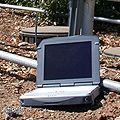


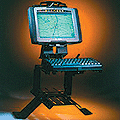





 The
The 
 their standard
their standard 




